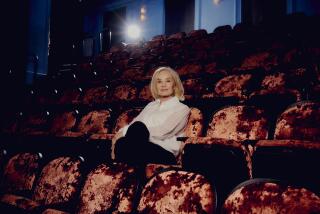MUSIC REVIEW
- Share via
There’s no doubt about it: Audiences love Lang Lang. At his Walt Disney Concert Hall recital Sunday night there seemed to be fewer empty seats than at Gustavo Dudamel’s sold-out Verdi Requiem on Friday. And before the standing ovation faded for Lang, a long line had formed downstairs to meet him.
As David Remnick suggested in a New Yorker profile last year, Lang is “an avatar of the Chinese ascendance” whose punishing programs display a titanic technique that thrills listeners. Here he performed two big Beethoven sonatas. After intermission came Book 1 of Albeniz’s “Iberia” and Prokofiev’s Sonata No. 7.
Lang is a Romantic in the Lisztian virtuoso mold, like Vladimir Horowitz before him. After an especially taxing movement, he reached for a white handkerchief placed inside the piano, recalling a signature Horowitz move.
Lang, who throws a warm sonic blanket over everything he performs, relies heavily on the sustaining pedal to manipulate the music. In Beethoven’s Sonata No. 3, he made the most of Beethoven’s playful dynamic contrasts in the opening Allegro. His deliberate phrasing created an improvisatory feel before dissolving into mannerism. In Beethoven’s mighty “Appassionata,” the pianist was unpredictably gentle in the opening, suggesting a ruminative composer working out revolutionary ideas. But once again, Lang wouldn’t let the music speak for itself -- he either slowed it to a crawl or took it at breakneck pace.
Lang is not bound by a musical era’s style. On this occasion, his Beethoven sounded like Schumann. Nor does he delve too deeply into the character of a particular work. The three pieces from Book 1 of Albeniz’s “Iberia” sounded more French than Spanish. Though there are harmonic links to Debussy -- the composers were contemporaries -- Lang never conveyed the special atmosphere or flavor of these dance-based pieces.
In Prokofiev’s Sonata No. 7, the pianist seemed to have little understanding of the work’s historical context. One of the composer’s three “war sonatas,” the score depicts a struggle that resolves by affirming an “irrepressible life-force,” in the words of Sviatoslav Richter, who premiered the work. Lang turned it into a splashy personal vehicle, performing the perpetual-motion toccata finale so fast that it lost steady rhythm and shape -- comparable to having the fastest serve in tennis that’s outside the lines.
Lang’s most sustained poetry came in the single lovely encore: Chopin’s “Aeolian Harp” Etude. Then he grabbed his hankie and waved it at the adoring audience. Another vintage Horowitz touch, signaling time to go.
--
More to Read
The biggest entertainment stories
Get our big stories about Hollywood, film, television, music, arts, culture and more right in your inbox as soon as they publish.
You may occasionally receive promotional content from the Los Angeles Times.










